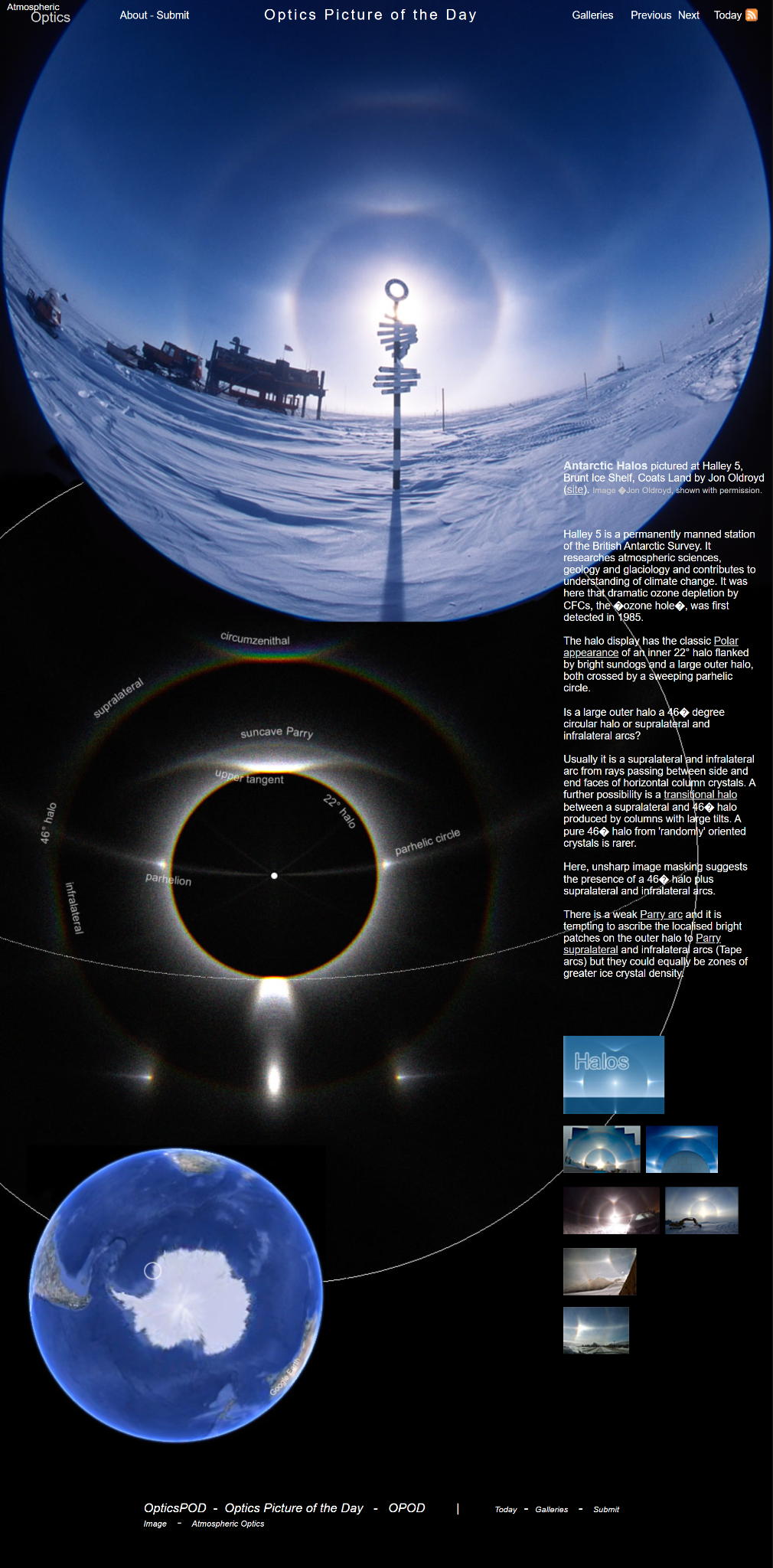Halley halos
Halley Halos: A Stunning Atmospheric Phenomenon
Halley 5, located on the Brunt Ice Shelf in Coats Land, is a research station operated by the British Antarctic Survey. This remote outpost focuses on studying atmospheric sciences, geology, and glaciology, making significant contributions to our understanding of climate change. It was at Halley 5 that scientists first detected the alarming depletion of ozone caused by chlorofluorocarbons (CFCs) in 1985, leading to the discovery of the infamous "ozone hole."
One of the most captivating displays witnessed at Halley 5 is the phenomenon known as "Halley halos." These halos present a classic polar appearance, characterized by an inner 22° halo accompanied by bright sundogs and a large outer halo. This breathtaking spectacle is further enhanced by the presence of a sweeping parhelic circle, completing the mesmerizing atmospheric display.
The large outer halo observed during Halley halos raises an intriguing question: Is it a 46° degree circular halo or something else? Typically, this outer halo manifests as a supralateral and infralateral arc, formed by rays passing between the side and end faces of horizontally-oriented column crystals. However, there is also the possibility of a transitional halo between a supralateral and a 46° halo, which can be produced by columns with significant tilts. The occurrence of a pure 46° halo resulting from randomly oriented crystals is relatively rare.
Analyzing images captured at Halley 5, researchers have employed unsharp image masking techniques to provide valuable insights into the nature of these halos. The analysis suggests the presence of a 46° halo alongside supralateral and infralateral arcs. However, it is important to note that the interpretation of these images is not definitive and requires further investigation.
In addition to the prominent halos, there are other intriguing features observed during Halley halos. A weak Parry arc can be detected, adding to the visual complexity of the phenomenon. Furthermore, localized bright patches observed on the outer halo might be attributed to Parry supralateral and infralateral arcs, also known as Tape arcs. However, it is equally plausible that these patches represent zones of greater ice crystal density. Further research and analysis are needed to conclusively determine the nature of these captivating phenomena.
Halley halos at the British Antarctic Survey's Halley 5 station provide a fascinating glimpse into the intricate world of atmospheric optics. The interplay between sunlight and ice crystals in the frigid Antarctic skies creates a mesmerizing display that continues to captivate scientists and observers alike. By unraveling the mysteries behind these halos, researchers at Halley 5 contribute to our broader understanding of atmospheric phenomena and their implications for climate change.
So, the next time you find yourself gazing up at the sky, remember that there is much more than meets the eye. The beauty and complexity of atmospheric optics, exemplified by Halley halos, serve as a reminder of the wonders that surround us, waiting to be explored and understood.

Antarctic Halos pictured at Halley 5, Brunt Ice Shelf, Coats Land by Jon Oldroyd (site). Image �Jon Oldroyd, shown with permission.
Halley 5 is a permanently manned station of the British Antarctic Survey. It researches atmospheric sciences, geology and glaciology and contributes to understanding of climate change. It was here that dramatic ozone depletion by CFCs, the �ozone hole�, was first detected in 1985.
The halo display has the classic Polar appearance of an inner 22° halo flanked by bright sundogs and a large outer halo, both crossed by a sweeping parhelic circle.
Is a large outer halo a 46� degree circular halo or supralateral and infralateral arcs?
Usually it is a supralateral and infralateral arc from rays passing between side and end faces of horizontal column crystals. A further possibility is a transitional halo between a supralateral and 46� halo produced by columns with large tilts. A pure 46� halo from 'randomly' oriented crystals is rarer.
Here, unsharp image masking suggests the presence of a 46� halo plus supralateral and infralateral arcs.
There is a weak Parry arc and it is tempting to ascribe the localised bright patches on the outer halo to Parry supralateral and infralateral arcs (Tape arcs) but they could equally be zones of greater ice crystal density.

Note: this article has been automatically converted from the old site and may not appear as intended. You can find the original article here.
Reference Atmospheric Optics
If you use any of the definitions, information, or data presented on Atmospheric Optics, please copy the link or reference below to properly credit us as the reference source. Thank you!
-
<a href="https://atoptics.co.uk/blog/halley-halos/">Halley halos</a>
-
"Halley halos". Atmospheric Optics. Accessed on November 25, 2024. https://atoptics.co.uk/blog/halley-halos/.
-
"Halley halos". Atmospheric Optics, https://atoptics.co.uk/blog/halley-halos/. Accessed 25 November, 2024
-
Halley halos. Atmospheric Optics. Retrieved from https://atoptics.co.uk/blog/halley-halos/.